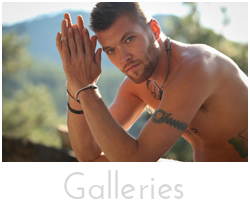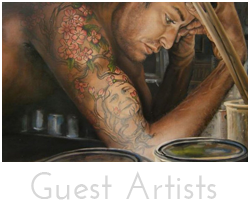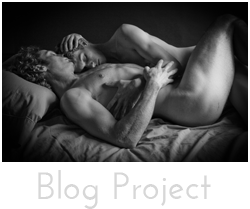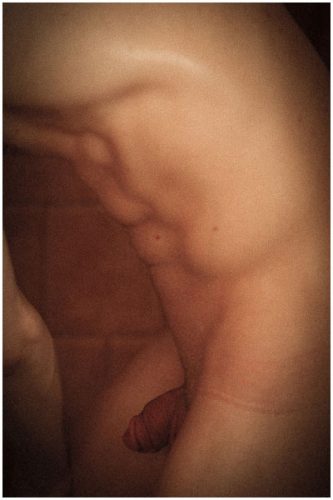 During my life in the theater I have stage managed in a lot of interesting places, but last night was probably one of the most unique experiences I’ve ever had. Several weeks back when Bill announced he was coming to Montana to do his show, he told me he had a one-night gig at a nudist resort in Northern Idaho called The Sun Meadow Resort just below Coeur d’Alene. He asked me if I would come along to become his technical director/stage manager. I immediately said yes. Bill and I have been on a lot of interesting adventures over the years and so this just seemed a natural for the both of us. It was about a 3 1/2 hour drive from Missoula and we arrived at mid-day. I wasn’t really nervous until we pulled into the parking lot and I knew the clothing thing was completely optional. But the moment we walked in the door we were greeted by Chas and Margie, our host for the event, completely naked. Well they had glasses and watches on. At first it was a bit awkward, because my eyes become riveted to theirs, not sure where to look. I think we are so used to checking each other out when we meet, but what is the etiquette for this type of situation when you see someone completely exposed right before your eyes? Granted I photograph people naked all the time, but generally the process is gradual, slowly removing the cloths, piece by piece, building up both our confidence levels so they can reveal and expose themselves. But to be greeted at the door to a stranger with nothing on, was a bit awkward.
During my life in the theater I have stage managed in a lot of interesting places, but last night was probably one of the most unique experiences I’ve ever had. Several weeks back when Bill announced he was coming to Montana to do his show, he told me he had a one-night gig at a nudist resort in Northern Idaho called The Sun Meadow Resort just below Coeur d’Alene. He asked me if I would come along to become his technical director/stage manager. I immediately said yes. Bill and I have been on a lot of interesting adventures over the years and so this just seemed a natural for the both of us. It was about a 3 1/2 hour drive from Missoula and we arrived at mid-day. I wasn’t really nervous until we pulled into the parking lot and I knew the clothing thing was completely optional. But the moment we walked in the door we were greeted by Chas and Margie, our host for the event, completely naked. Well they had glasses and watches on. At first it was a bit awkward, because my eyes become riveted to theirs, not sure where to look. I think we are so used to checking each other out when we meet, but what is the etiquette for this type of situation when you see someone completely exposed right before your eyes? Granted I photograph people naked all the time, but generally the process is gradual, slowly removing the cloths, piece by piece, building up both our confidence levels so they can reveal and expose themselves. But to be greeted at the door to a stranger with nothing on, was a bit awkward.
We very quickly began to set the show up, with our cloths on. The place was excessively hot and I quickly began to sweat break into a sweat. Slowly the cloths began to come off; first the over shirt I was wearing, then the t-shirt, as I was scurrying about trying to figure out how to get this show up. So finally I made the leap. I went to my room, which was behind the stage area, and stripped out of my cloths; it’s odd because there are no closets. I then went out to run the technical light and sound cues for the show. But before I went out, I lingered in the doorway hidden really questioning and doubting if I should even go out into the common area. I am not sure why? It was such an interesting moment when I really had to confront myself, deal with my own naked moment. I sometimes run around the studio naked, but generally just from the bathroom after a shower to the closet in the bedroom to get my clothes. I feel like I am comfortable with myself. In fact I was going through some old photos last week of a trip to Glacier Park 20 years ago and went swimming naked in the lake and was surprised how much my body has not changed in all these years. Yes I have put on a little more weight since those days, but have aged well for a man about to turn 50 in a couple of weeks. The room I was about to enter was filled with nude people just casually going about their business. So what was the hesitation? It’s felt very odd and I thought perhaps I should just go put my cloths back on. This debate raged in my head for several moments and finally I entered the room, completely nude, went to my workstation, and began working though the script and cues adapting them for this show. About 10 minutes later a very large family came into the resort. My worked table was just inside the door, and I have to say I kind of freaked out a bit; here I sat working in front of all these children completely exposed. They were clothed but I thought, “Have these people gotten here by mistake?” I remembered that it was an electronic gate to enter, so there could be no mistake. But it still felt uncomfortable there were about 7 children ranging in ages from 3 weeks to early teen, boys and girls. My guy impulse was to hide myself, out of fear or shame I couldn’t decide which. In our culture to expose oneself to children becomes taboo because I think people are afraid it will leave an emotionally distress on the child. And nakedness to child becomes viewed in a perverse context. But the children were comfortable and the feelings past. When I finished my tech I actually went out to the pool to join them for a swim. I soon began to meet and talk to people at this resort and I was amazed at how the inhibitions seem to vanish. You are confronted with seeing the person for who they are, right there in front of you, in that moment. No attitude or social status is projects though what they are wearing and you tend to make more direct eye contact to whom you are talking. In a sense it breathes a certain amount of honesty into the encounter, because there are no masks, no distractions. You look deeper into their eyes and see the truths they are telling about themselves and their lives. There is no place to hide, because the eyes are the windows to our souls as you become completely exposed.
The show was a hit, although Bill did not do it in the nude. The audience was completely moved by it and had lots of questions about these gay boys from Missoula and how our lives have been shrouded by reluctance and silence and a certain amount of shame. They deeply connected to the struggle of fighting for their own liberation in a society that is not always so giving of their lifestyle choices. It was an enriching experience to have been given this opportunity.
I feel like in so many ways with this project I have bared myself emotionally and mentally, but this is the first time physically until now. It really begs to answer a question for me: Why are we so afraid to confront the nakedness of ourselves? What it would be like to live in a life with little discrimination or barriers? There is a key to this puzzle somewhere here, but I am not going to learn it over night as a stranger passing through.
The only draw back is that my feet have become chaffed from walking around bare because I don’t even go barefoot at home. Perhaps I need to expose myself a little more.

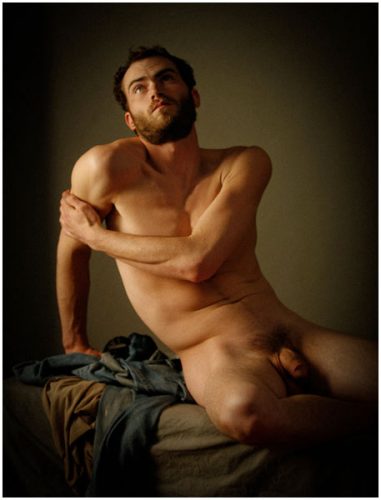 The other day Glenn asked me how does one transfer the light design of one show to another and I began to ramble on for about an hour about how we as designers can create a show and have it remain adaptable yet consistent from venue to venue. But mostly what I went off about was the psychology of light; the impact light has on the performers and the audience. For instance there is a moment in Billy’s show after his partner’s brain begin to malfunction and he loses control of his motor skills and the only way Bill is able to communicate with him is though a series of events which become progressively worse. I designed this sequence where the stage is bright when we begin and as Michael’s tumor becomes worse. I begin to close down and restrict the light on Billy down to a single pure white spot. Billy always likes to run his shows with some of the house lights up on the audience so he can see and interact with them. So as this lighting sequence progresses, even the house lights fade to leave the audience in the dark. I bring this sequence up because it’s the emotional climax of the play and I want to illustrate the psychology of lighting. And this is a great scene because it exists on so many levels. First it mirrors what’s happening within the story of a man dealing with his partner slowing becoming paralyzed and eventually dying of a brain tumor from the late stages of AIDS. As things are taken away from the characters of the story the light also becomes stripped away. The first thing that begins to fade is the color with in the light. Theater lights are colored by thin transparent gels that come in a variety of shades, typically a lighting design will have balance of some warm colors (yellow to reds) and some cool colors (lavenders to blues). These colors are used to control the mood of the play; you can either warm it up or cool it down to match the psychology of what’s happening with the actors within the scene. So the first thing to go in this scene is the color and warmth the stage had been bathed in. The next part is to use the light to represent the presence of Michael, through the light and how he sees Billy. As his brain begins to deteriorate and shut down and become more restrictive so does the light. I keep taking it away very slowly so that the audience is not perceptive of the movement and confinement of the moment. All the while the house lights have also followed this progression of the confinement closing the audience into the darkness. In moments like this it is essential for the audience to have their own privacy to identify with and connect to this grieving process. Often times in moments like this the audience will become so emotionally shaken and overwhelmed that they often cry from the heart break of the emotional journey of the character on stage. Isolating down gives them this privacy in the darkness so they can publicly grieve with the character and this is what makes live theater so interactive.
The other day Glenn asked me how does one transfer the light design of one show to another and I began to ramble on for about an hour about how we as designers can create a show and have it remain adaptable yet consistent from venue to venue. But mostly what I went off about was the psychology of light; the impact light has on the performers and the audience. For instance there is a moment in Billy’s show after his partner’s brain begin to malfunction and he loses control of his motor skills and the only way Bill is able to communicate with him is though a series of events which become progressively worse. I designed this sequence where the stage is bright when we begin and as Michael’s tumor becomes worse. I begin to close down and restrict the light on Billy down to a single pure white spot. Billy always likes to run his shows with some of the house lights up on the audience so he can see and interact with them. So as this lighting sequence progresses, even the house lights fade to leave the audience in the dark. I bring this sequence up because it’s the emotional climax of the play and I want to illustrate the psychology of lighting. And this is a great scene because it exists on so many levels. First it mirrors what’s happening within the story of a man dealing with his partner slowing becoming paralyzed and eventually dying of a brain tumor from the late stages of AIDS. As things are taken away from the characters of the story the light also becomes stripped away. The first thing that begins to fade is the color with in the light. Theater lights are colored by thin transparent gels that come in a variety of shades, typically a lighting design will have balance of some warm colors (yellow to reds) and some cool colors (lavenders to blues). These colors are used to control the mood of the play; you can either warm it up or cool it down to match the psychology of what’s happening with the actors within the scene. So the first thing to go in this scene is the color and warmth the stage had been bathed in. The next part is to use the light to represent the presence of Michael, through the light and how he sees Billy. As his brain begins to deteriorate and shut down and become more restrictive so does the light. I keep taking it away very slowly so that the audience is not perceptive of the movement and confinement of the moment. All the while the house lights have also followed this progression of the confinement closing the audience into the darkness. In moments like this it is essential for the audience to have their own privacy to identify with and connect to this grieving process. Often times in moments like this the audience will become so emotionally shaken and overwhelmed that they often cry from the heart break of the emotional journey of the character on stage. Isolating down gives them this privacy in the darkness so they can publicly grieve with the character and this is what makes live theater so interactive.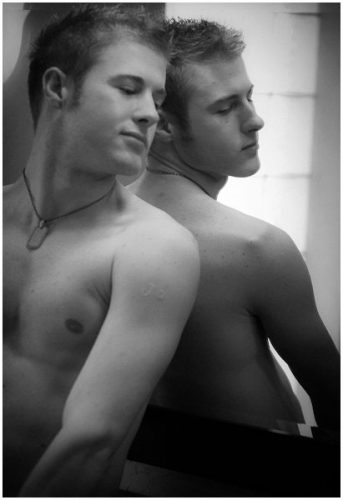 My father loved the show last night. I think he was very emotionally caught up in the stories Bill was telling about being growing up gay in Montana, feeling the isolation, and the loss of his partner from AIDS in the 90’s. I watched him laugh at all the Montana character studies. When it was over he said it was very sad. I saw the show differently last night, because this time I was watching it through the eyes of my father and I found the play much more emotionally riveting then I ever have. Bill talks about growing up in a world there actions speak louder then words and paints a very harsh reality of living in an era of not being able to communicate. In one particular instance he talks about his father hiring a sky writer to write across the western sky “ I love you Vern” to his mother before he died “Easier done than said.” I think the bane of many gay men is that we don’t know how to break that silence with our families. It seems to become tougher to communicate. Yesterday someone commented about not being able to talk to my father who gave me birth yet I am able to honestly put it out there to strangers. This has been on my mind all morning. Bill said when his mother saw the show, and he is very blunt and honest in talking about their family dynamics growing up, that she never said anything to him about any of it but that she had talked to everyone else. Perhaps we see ourselves and life differently then others perceive us. We all live so closely and want to view the lives of our siblings as the way we remember them as kids. I have never really shared my private life with other member of my family. It’s not that I don’t want to, it’s just the way we grew up; we were not much of a family to share those feelings. Don’t get me wrong, I love and adore my father and think he is a remarkable man, he always has been. I know he admires me and has told me. I am just very unconventional to his norm. It’s hard to get the concept of my identity when I have had such a struggling coming to terms of understanding my own identity. Glenn’s Aunt Ruth, who is older than my father, has been following this blog is more of his era, keep saying believe and accept yourself. She seems to be having a hard time with this concept of the identity crisis that we as a gay culture have gone though and why I keep harping on it. But to be gay during my era was a struggle for self-respect, dignity, and understanding. I was isolated from the rest of my peers and dealt with a whole host of socialization issues that create such inner turmoil. Yes the basic human emotions and response should be the same, and they are ever becoming so, but it has not always been this easy. There were no role models, no icons to look up to, no art that showed positive reinforcement that it was OK to be this way. Just desperate whispers in the darkness. It’s one of the reason’s I create what I create, to redefine and show ourselves emerging in a positive light from this darkness. There is light and beauty in this world and I now live a life filled with hope and joy every day, but a part of my history and growth has been the evolution of finding myself. The journey of this project is not always about the present, but part of the memory and pain in exploring how I got to this moment in my existence. It is not meant to be a judgment of myself or others but an honest recounting of one man’s voyage to himself. So in a sense this non-direct communication with my father is not about us at all. It’s about my own identity and how it’s shaped the destiny of what I am becoming and has very little to do with our current relationship. I have to laugh because all after the show last night my dad was doing all these funky mime movements and I knew in my heart he really got it.
My father loved the show last night. I think he was very emotionally caught up in the stories Bill was telling about being growing up gay in Montana, feeling the isolation, and the loss of his partner from AIDS in the 90’s. I watched him laugh at all the Montana character studies. When it was over he said it was very sad. I saw the show differently last night, because this time I was watching it through the eyes of my father and I found the play much more emotionally riveting then I ever have. Bill talks about growing up in a world there actions speak louder then words and paints a very harsh reality of living in an era of not being able to communicate. In one particular instance he talks about his father hiring a sky writer to write across the western sky “ I love you Vern” to his mother before he died “Easier done than said.” I think the bane of many gay men is that we don’t know how to break that silence with our families. It seems to become tougher to communicate. Yesterday someone commented about not being able to talk to my father who gave me birth yet I am able to honestly put it out there to strangers. This has been on my mind all morning. Bill said when his mother saw the show, and he is very blunt and honest in talking about their family dynamics growing up, that she never said anything to him about any of it but that she had talked to everyone else. Perhaps we see ourselves and life differently then others perceive us. We all live so closely and want to view the lives of our siblings as the way we remember them as kids. I have never really shared my private life with other member of my family. It’s not that I don’t want to, it’s just the way we grew up; we were not much of a family to share those feelings. Don’t get me wrong, I love and adore my father and think he is a remarkable man, he always has been. I know he admires me and has told me. I am just very unconventional to his norm. It’s hard to get the concept of my identity when I have had such a struggling coming to terms of understanding my own identity. Glenn’s Aunt Ruth, who is older than my father, has been following this blog is more of his era, keep saying believe and accept yourself. She seems to be having a hard time with this concept of the identity crisis that we as a gay culture have gone though and why I keep harping on it. But to be gay during my era was a struggle for self-respect, dignity, and understanding. I was isolated from the rest of my peers and dealt with a whole host of socialization issues that create such inner turmoil. Yes the basic human emotions and response should be the same, and they are ever becoming so, but it has not always been this easy. There were no role models, no icons to look up to, no art that showed positive reinforcement that it was OK to be this way. Just desperate whispers in the darkness. It’s one of the reason’s I create what I create, to redefine and show ourselves emerging in a positive light from this darkness. There is light and beauty in this world and I now live a life filled with hope and joy every day, but a part of my history and growth has been the evolution of finding myself. The journey of this project is not always about the present, but part of the memory and pain in exploring how I got to this moment in my existence. It is not meant to be a judgment of myself or others but an honest recounting of one man’s voyage to himself. So in a sense this non-direct communication with my father is not about us at all. It’s about my own identity and how it’s shaped the destiny of what I am becoming and has very little to do with our current relationship. I have to laugh because all after the show last night my dad was doing all these funky mime movements and I knew in my heart he really got it.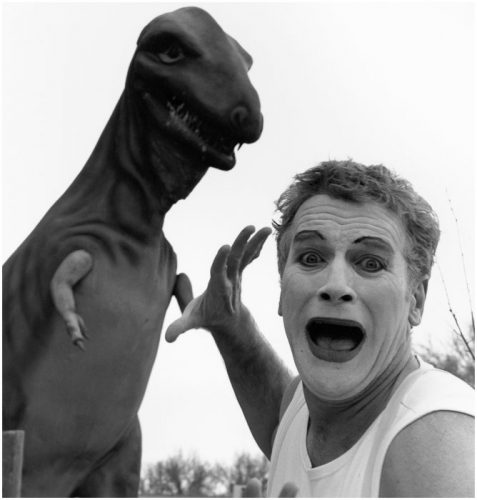 What started off with a simple joke for Bill this morning has now turned into a major fashion design for a mime. I’ve been photographing Bill over the years in various locations of Montana dressed as a mime. Many years ago when I first got my Hasselblad camera, Bill planned to bring his mime show
What started off with a simple joke for Bill this morning has now turned into a major fashion design for a mime. I’ve been photographing Bill over the years in various locations of Montana dressed as a mime. Many years ago when I first got my Hasselblad camera, Bill planned to bring his mime show 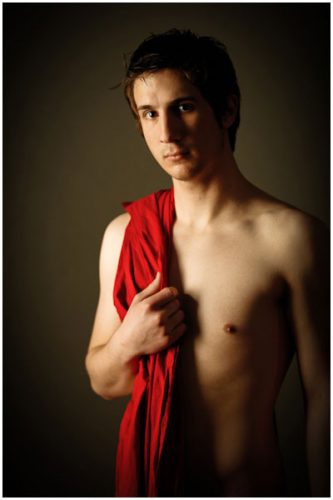 This is one of my favorite terms in photography because the basic theory applies to so much of life. I haven’t written about anything photographic in a while and began a crash course on photography some weeks back. So here is the second term photographers need to know in making a creative choice when using their cameras. Last time I talked about apertures and shutter. The aperture controls the depth of field in an image. The basic concept is the elements of the images that are in focus from the front of the subject to the back of the subject. For instance a landscape image has a greater depth of field, (the foreground is as sharp as the background mountains in the distance) than a portrait (where only the subject or a particular feature of the subject is in focus and everything in front of or behind is a blur). Today’s close up image of Corey. His eye becomes the focus and the red cloth on his shoulder is just slightly blurred, because this image was more about Corey’s connection to me as I was taking the image and the viewer who will eventually see the image. The way the camera controls this is by how tight or open the aperture on the lens is set. On a lens this is measured by f/stops. You will often see numbers 2.8, 4, 5.6, 8, 11, 16, 22, and 32. Oddly enough, they work in reverse of what you would logically think. The smaller the number the wider the opening and the more light it lets into the camera and the larger the number the more restricted the light into the camera. Each increment lets in double the amount of light as the previous, this is known as full f/stops. So the way to think about this process is that if f/2.8 is wide open it lets a great deal of light in to be recorded in a instant. It would be like if we close our eyes and open them in a new location, that we have never been and we just glace at this environment for that quick instant what do we actually take in a see: most people just what’s in front of them. The plane of the depth of what we remember is very narrow. The aperture works the same. It will record a very narrow depth in the image. Whereas if we restrict down the opening f/32. It’s almost like squinting and you have to observe the scene longer to take in the environment. The longer you look the more information your brain records, therefore more detail in the image because a greater part of the image is in focus.
This is one of my favorite terms in photography because the basic theory applies to so much of life. I haven’t written about anything photographic in a while and began a crash course on photography some weeks back. So here is the second term photographers need to know in making a creative choice when using their cameras. Last time I talked about apertures and shutter. The aperture controls the depth of field in an image. The basic concept is the elements of the images that are in focus from the front of the subject to the back of the subject. For instance a landscape image has a greater depth of field, (the foreground is as sharp as the background mountains in the distance) than a portrait (where only the subject or a particular feature of the subject is in focus and everything in front of or behind is a blur). Today’s close up image of Corey. His eye becomes the focus and the red cloth on his shoulder is just slightly blurred, because this image was more about Corey’s connection to me as I was taking the image and the viewer who will eventually see the image. The way the camera controls this is by how tight or open the aperture on the lens is set. On a lens this is measured by f/stops. You will often see numbers 2.8, 4, 5.6, 8, 11, 16, 22, and 32. Oddly enough, they work in reverse of what you would logically think. The smaller the number the wider the opening and the more light it lets into the camera and the larger the number the more restricted the light into the camera. Each increment lets in double the amount of light as the previous, this is known as full f/stops. So the way to think about this process is that if f/2.8 is wide open it lets a great deal of light in to be recorded in a instant. It would be like if we close our eyes and open them in a new location, that we have never been and we just glace at this environment for that quick instant what do we actually take in a see: most people just what’s in front of them. The plane of the depth of what we remember is very narrow. The aperture works the same. It will record a very narrow depth in the image. Whereas if we restrict down the opening f/32. It’s almost like squinting and you have to observe the scene longer to take in the environment. The longer you look the more information your brain records, therefore more detail in the image because a greater part of the image is in focus.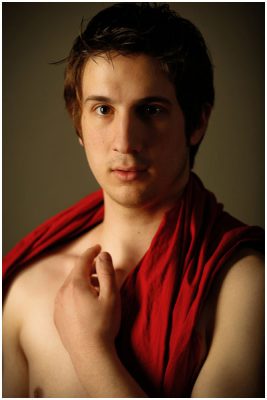 The next image of Corey draws you more into his gentle seductive nature as a whole; the beauty of his skin color contrasted with the red fabric. I used a wider aperture to draw the viewer out to see the over all impression, it become more about mood than connection. Yet I still blur the environment so the image becomes timeless, not connected to any particular place. Last time I talked about putting your camera in an aperture priority mode. This is the best way to learn it. In this mode you get to choose the aperture and the shutter automatically adjusts the expose for the near perfect exposure. So the next time you are out with your camera and you want to take a picture, stop for just a moment and ask, what is my original impulse to take this particular picture? Now ask you self, what is my subject and how do I want to record this subject? Is the environment important? Then begin to narrow your focus to what it is that drew you to take the image in the first place.
The next image of Corey draws you more into his gentle seductive nature as a whole; the beauty of his skin color contrasted with the red fabric. I used a wider aperture to draw the viewer out to see the over all impression, it become more about mood than connection. Yet I still blur the environment so the image becomes timeless, not connected to any particular place. Last time I talked about putting your camera in an aperture priority mode. This is the best way to learn it. In this mode you get to choose the aperture and the shutter automatically adjusts the expose for the near perfect exposure. So the next time you are out with your camera and you want to take a picture, stop for just a moment and ask, what is my original impulse to take this particular picture? Now ask you self, what is my subject and how do I want to record this subject? Is the environment important? Then begin to narrow your focus to what it is that drew you to take the image in the first place.